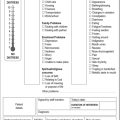20 Receiving a cancer diagnosis
Diagnostic investigations
Register with the free Macmillan ‘Learn Zone’ on the following Website:
http://learnzone.macmillan.org.uk (accessed November 2011).
Johnson G.B.. Cancer diagnosis and staging. Langhorne M.E., Fulton J.S., Otto S.E. Oncology nursing, fifth ed., St Louis: Mosby, 2007.
Montgomery M., McCrone S. Psychological distress associated with the diagnostic phase for suspected breast cancer: systematic review. J. Adv. Nurs.. 2010;66(11):2372–2390.
Case update
Points to consider
Preoperative care
NMC Domain 1: 1.1; 1.2; 1.4; 1.7
NMC Domain 2: 2.1; 2.2 2.3; 2.7; 2.8
Caulfield H. Vital notes for nurses: accountability. Edinburgh: Wiley-Blackwell; 2005.
Ford L. Consent and capacity: a guide for district nurses. Br. J. Community Nurs.. 2010;15(9):456–460.
Mental Capacity Act. London: The Stationery Office; 2005.
Pudner R. Nursing the surgical patient, third ed. Edinburgh: Baillière Tindall; 2010.


